Fabrication of Piezoelectric PVDF/PAR Composites Using a Sheath-Core Fiber Method
Abstract
:1. Introduction
2. Materials and Methods
2.1. Melt Spinning of Sheath-Core Fiber
2.2. Preparation of PVDF/PAR Composites
2.3. Post-Treatment of the Composites
2.4. Zinc Oxide Surface Coating
2.5. Characterization
3. Results
3.1. Sheath-Core Fiber Morphologies
3.2. Composite Manufacturing and Mechanical Property (Tensile Properties)
3.3. Post-Treatment Effects
3.3.1. FT-IR Analysis
3.3.2. X-ray Diffraction (XRD) Analysis
3.4. Piezoelectric Properties
3.5. ZnO Coating Effects
3.5.1. Morphologies
3.5.2. X-ray Diffraction (XRD) Analysis
3.5.3. Piezoelectric Property
4. Conclusions
Author Contributions
Funding
Conflicts of Interest
References
- Ueberschlag, P. PVDF pidezoelectric polymer. Sens. Rev. 2001, 21, 118–125. [Google Scholar] [CrossRef]
- Kawai, H. The piezoelectricity of poly (vinylidene fluoride). Jpn. J. Appl. Phys. 1969, 8, 975. [Google Scholar] [CrossRef]
- Ye, Y.; Jiang, Y.; Wu, Z.; Zeng, H.; Li, W. Characterization and Ferroelectric properties of electric poled PVDF Films. Int. Symp. Electrets 2005, 12, 132–135. [Google Scholar]
- Costa, L.M.M.; Bretas, R.E.S.; Gregorio, R. Effect of solution concentration on the electrospray/electrospinning transition and on the crystalline phase of PVDF. Mater. Sci. Appl. 2010, 1, 247–252. [Google Scholar] [CrossRef] [Green Version]
- Broadhurst, M.G.; Davis, G.T.; McKinney, J.E.; Collins, R.E. Piezoelectricity and pyroelectricity in poly (vinylidene fluoride)—A model. J. Appl. Phys. 1978, 49, 4992–4997. [Google Scholar] [CrossRef]
- Tashiro, K. Crystal structure and phase transition of PVDF and related copolymers. Plast. Eng. N. Y. 1995, 28, 63. [Google Scholar]
- Gregorio, R., Jr. Determination of the α, β, and 16 crystalline phases of poly(vinlylidene fluoride) films prepared at different conditions. Appl. Polym. 2006, 100, 3272–3279. [Google Scholar] [CrossRef]
- Liu, Y.Z.; Zhang, H.; Yu, J.X.; Huang, Z.Y.; Wang, C.; Sun, Y. Ferroelectric P(VDF-TrFE)/POSS nanocomposite films: Compatibility, piezoelectricity, energy harvesting performance, and mechanical and atomic oxygen erosion. RSC Adv. 2020, 10, 17377–17386. [Google Scholar] [CrossRef]
- Liu, Y.Z.; Hao, Z.W.; Yu, J.X.; Zhou, X.R.; Lee, P.S.; Sun, Y.; Mu, Z.C.; Zeng, F.L. A high-performance soft actuator based on a poly(vinylidene fluoride) piezoelectric bimorph. Smart Mater. Struct. 2019, 28, 055011. [Google Scholar] [CrossRef]
- Jin, L.; Ma, S.; Deng, W.; Yan, C.; Yang, T.; Chu, X.; Tian, G.; Xiong, D.; Lu, J.; Yang, W. Polarization-free high-crystalline β-PVDF pieoelectric nanogenerator toward self-powered 3D acceleration sensor. Nano Energy 2018, 50, 632–638. [Google Scholar] [CrossRef]
- Kamiya, T. Calculation of crystal structures, dielectric constants and piezoelectric properties of wurtzite-type crystals using ab-initio periodic Hartree-Fock method. Jpn. J. Appl. Phys. 1996, 35, 4421. [Google Scholar] [CrossRef]
- Gregorio, R.J.; Cestari, M. Effect of crystallization temperature on the crystalline phase content and morphology of poly(vinylidene fluoride). Polym. Phys. 1994, 32, 859–870. [Google Scholar]
- Choi, S.W.; Kim, J.R.; Ahn, Y.R.; Jo, S.M.; Cairns, E.J. Characterization of electrospun PVDF fiber based polymer electrolytes. Chem. Mater. 2007, 19, 104–115. [Google Scholar] [CrossRef]
- Lee, I.; Sung, H.J. Development of an array of pressure sensors with PVDF film. Exp. Fluids 1999, 26, 27–35. [Google Scholar] [CrossRef]
- Shirinov, A.V.; Schomburg, W.K. Pressure sensor form a PVDF film. Sens. Actuators 2008, 142, 48–55. [Google Scholar] [CrossRef]
- Mohammadi, B.; Yousefi, A.A.; Bellah, S.M. Effect of tensile strain rate and elongation on crystalline structure and piezoelectric properties of PVDF thin films. Polym. Test. 2007, 26, 42–50. [Google Scholar] [CrossRef]
- Oh, W.J.; Lim, H.S.; Won, J.S.; Lee, S.G. Preparation of PVDF/PAR composite with piezoelectric properties by post-treatment. Polymers 2018, 10, 1333. [Google Scholar] [CrossRef] [Green Version]
- Singh, H.H.; Khare, N. Flexible ZnO-PVDF/PTFE Based Piezo-Tribo Hybrid Nanogenerator. Nano Energy 2018, 51, 216–222. [Google Scholar] [CrossRef]
- Nicholas, N.J.; Franks, G.V.; Ducher, W.A. The mechanism for hydrotheraml growth of zinc oxdie. CrystEngComn 2012, 14, 1232–1240. [Google Scholar] [CrossRef]
- Salmi, A.; Yousefi, A.A. FT-IR Studieds of β-phase crystal formation in stretched PVDF films. Polym. Test. 2003, 22, 699. [Google Scholar]
- Wang, W.; Cakmak, M.; White, J.L. Structure development in melt spinning poly(vinylidene Fluoride) fiber and tapes. Polym. Sci. 1985, 30, 2615–2632. [Google Scholar] [CrossRef]
- Kou, L.Z.; Guo, W.L. Piezoelectricity of ZnO and its nanostructures. In Proceedings of the 2008 Symposium on Piezoelectricity, Acoustic Waves, and Device Applications, Nanjing, China, 5–8 December 2008; pp. 354–359. [Google Scholar] [CrossRef]
- Finch, G.I.; Quarrell, A.G. Crystal structure and orientation in zinc-oxide films. Proc. Phys. Soc. 1933, 46, 148–162. [Google Scholar] [CrossRef]


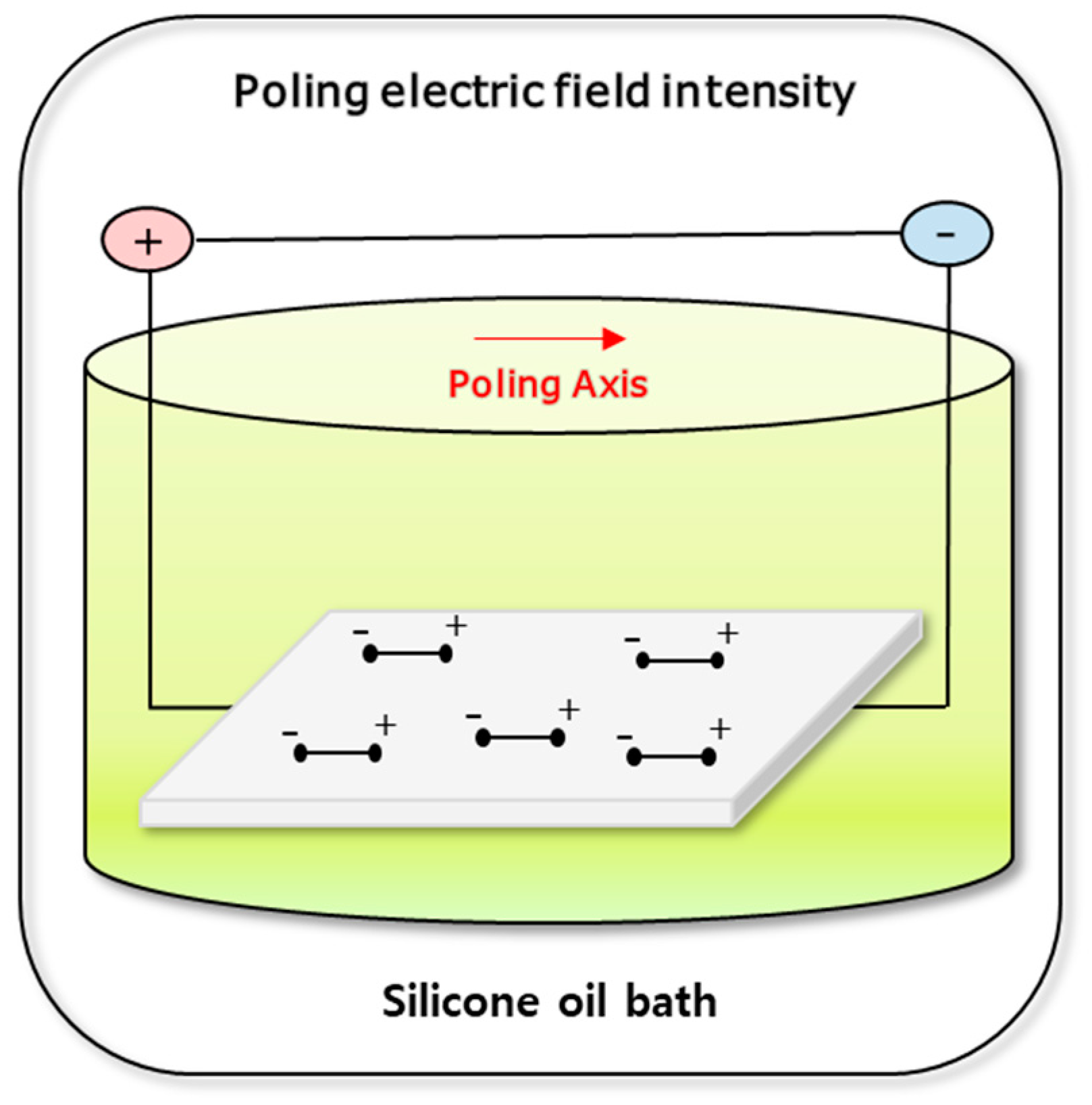
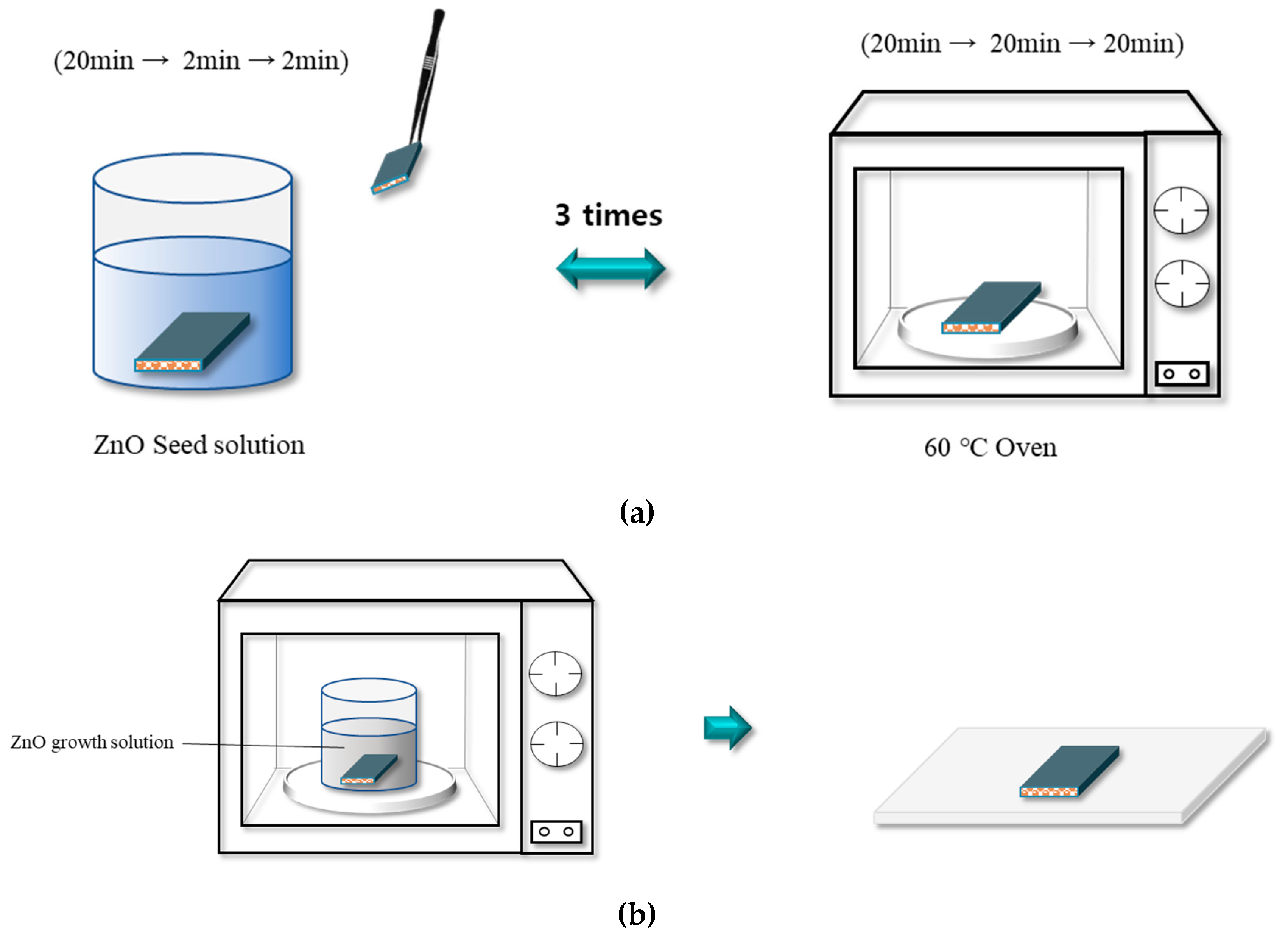
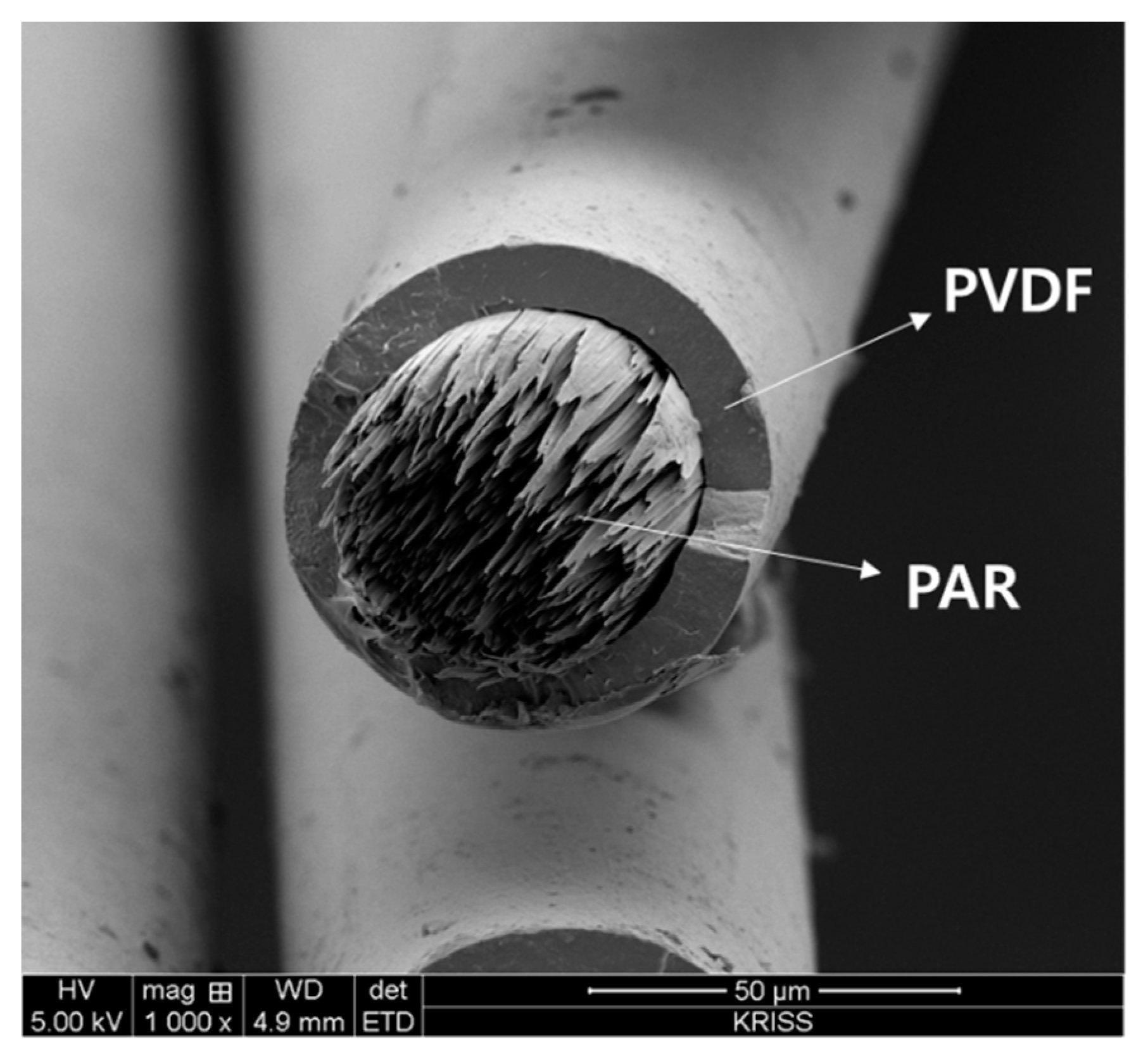
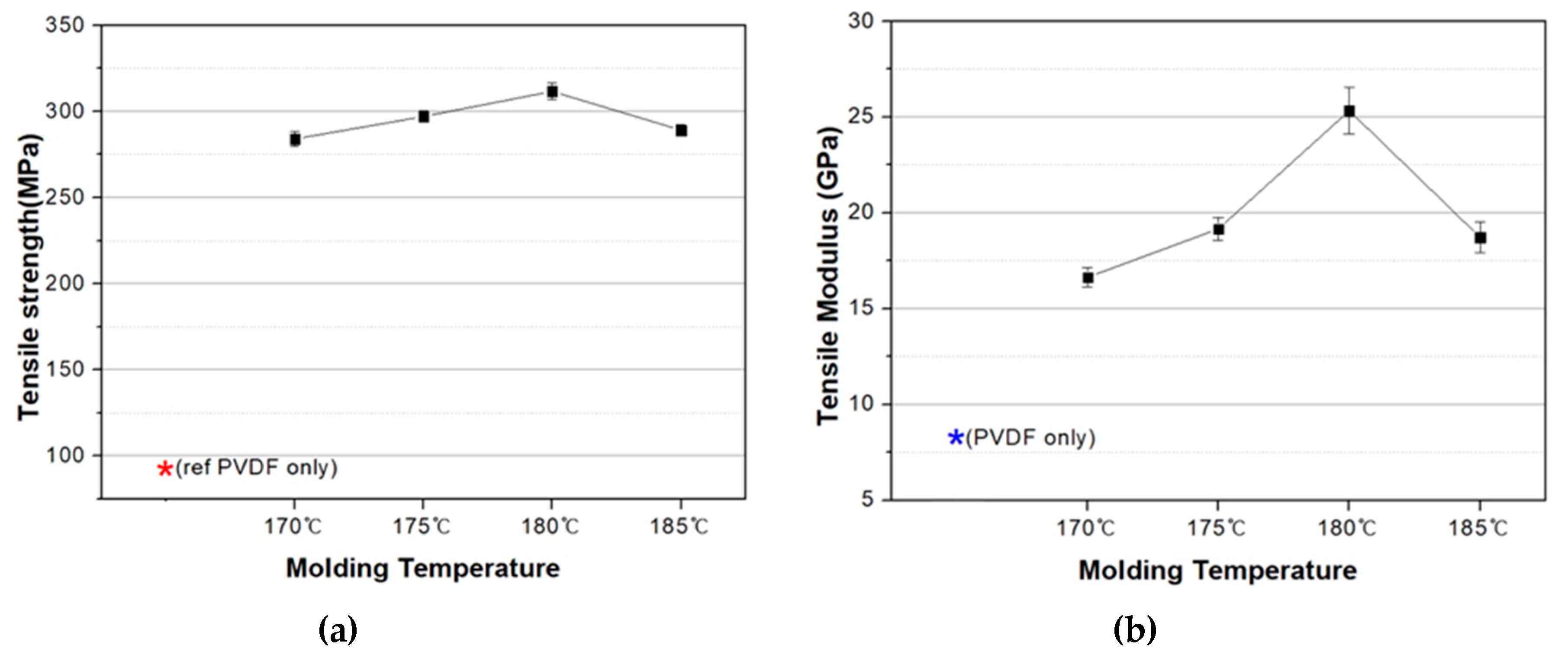
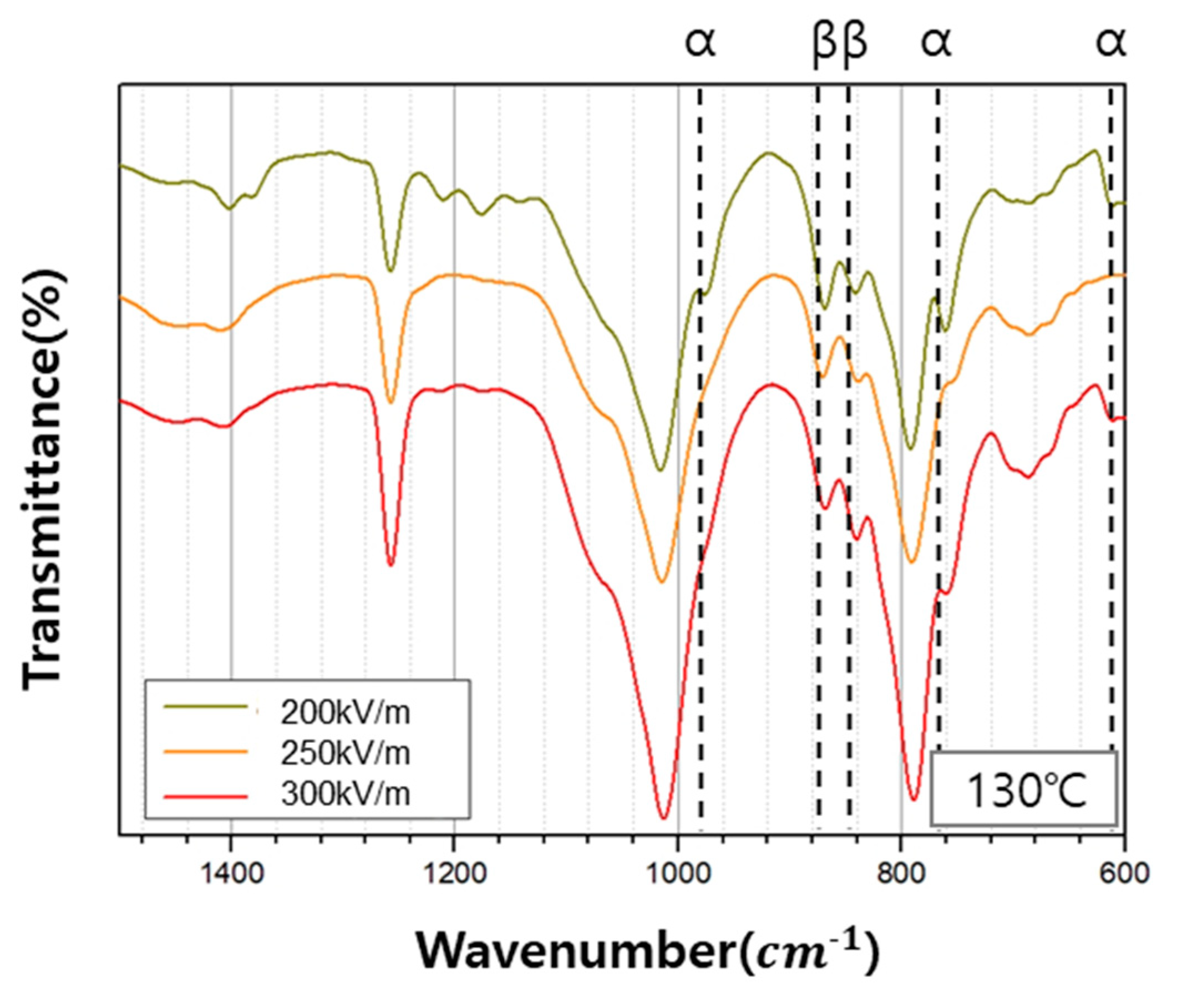
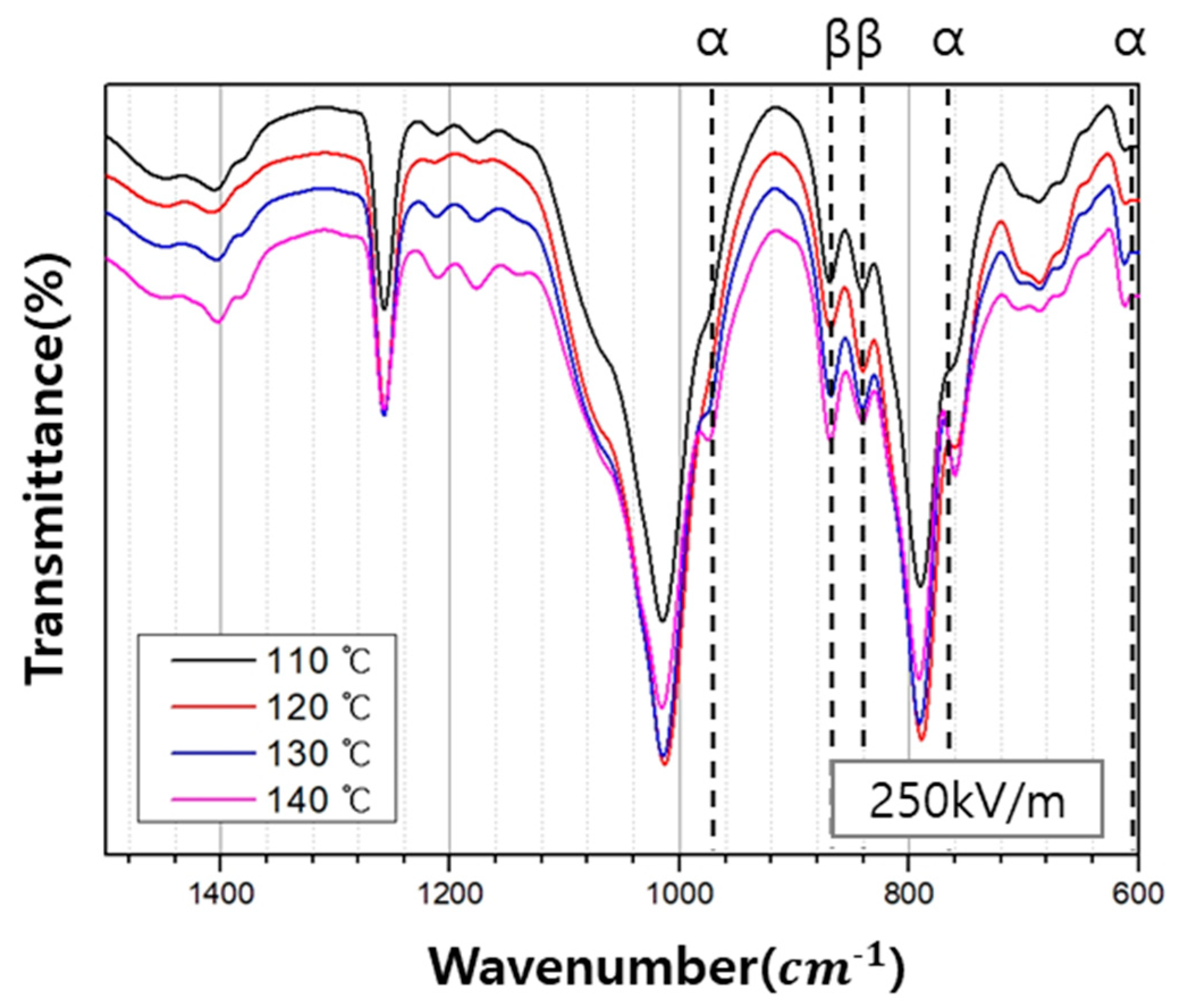

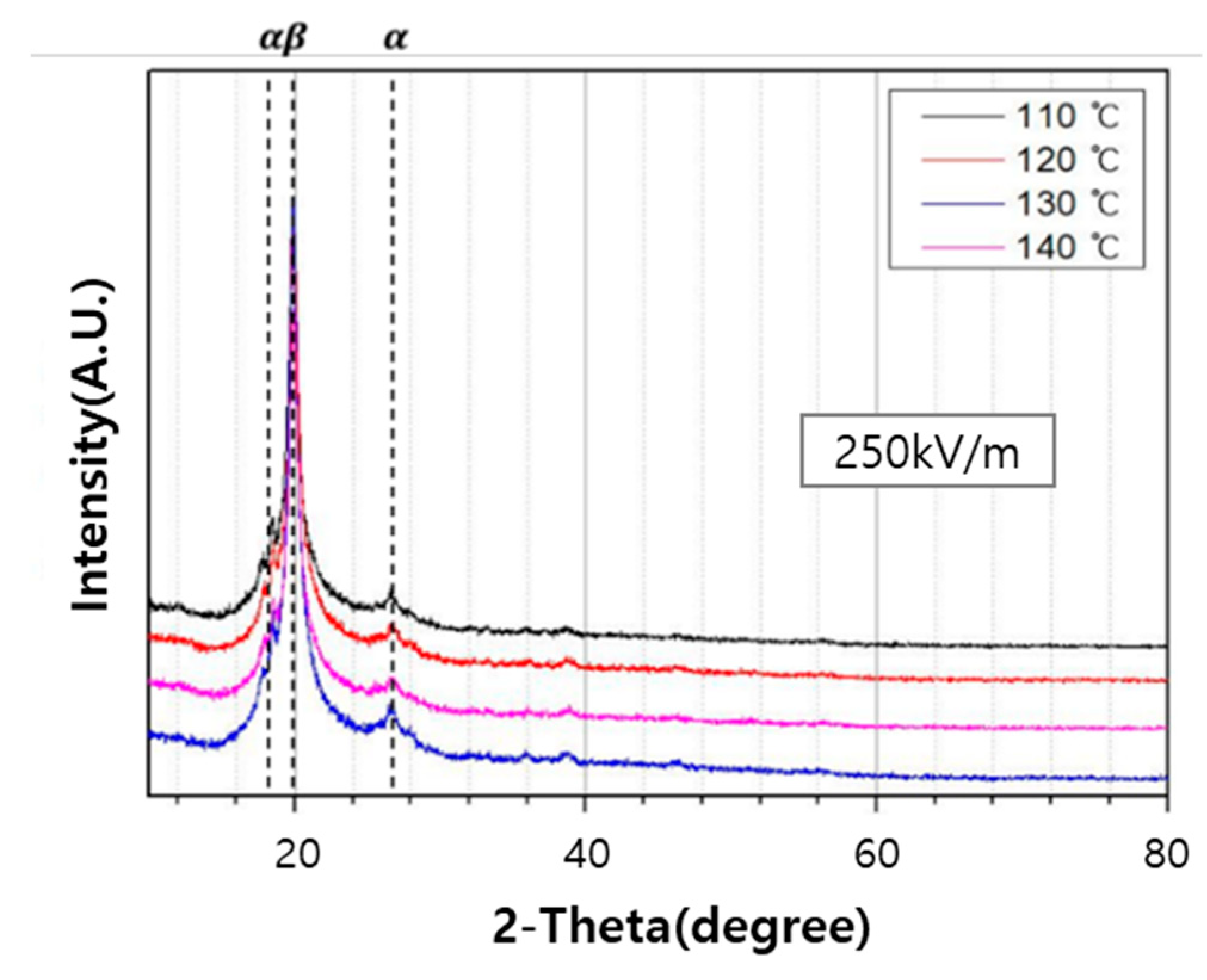


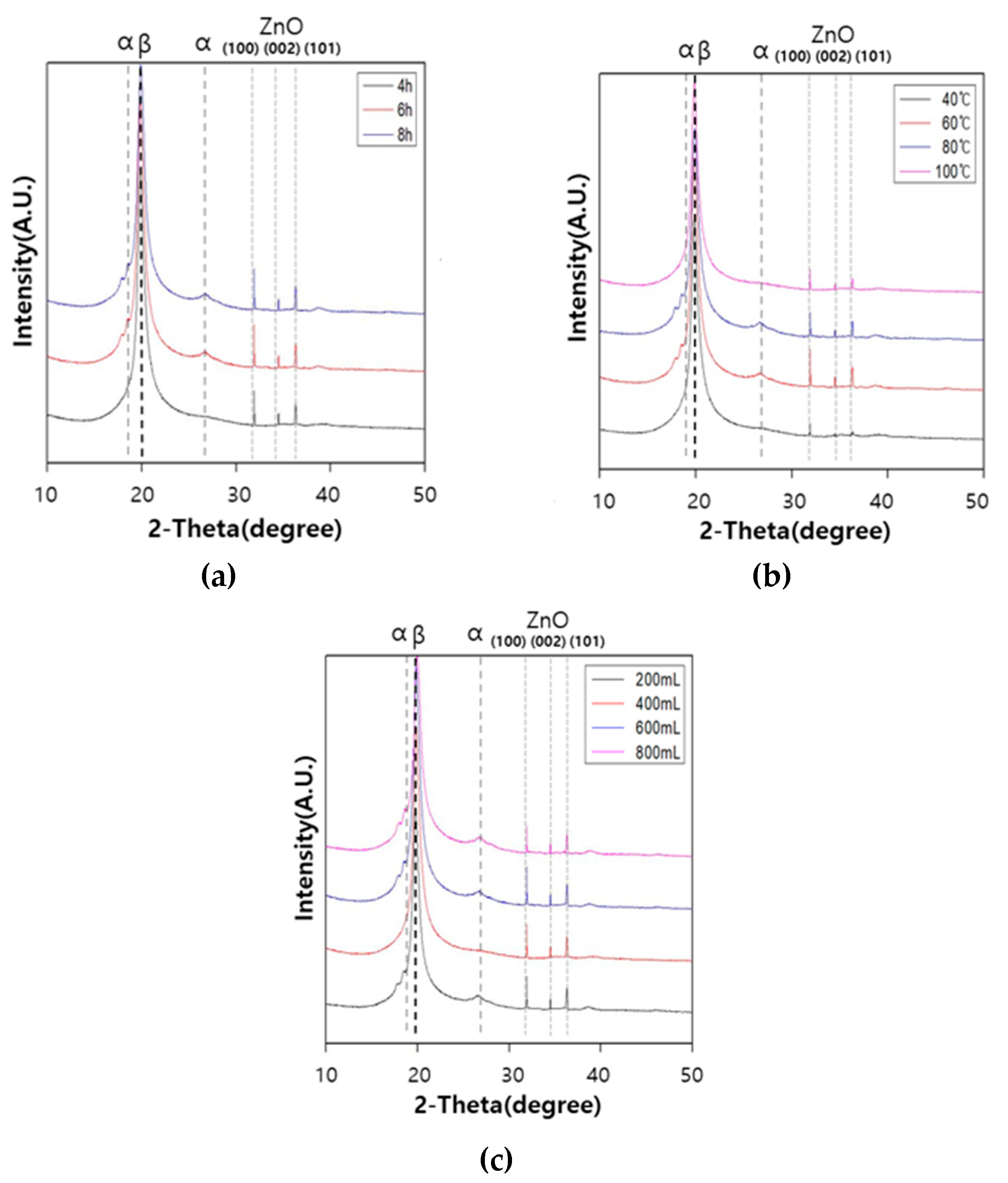
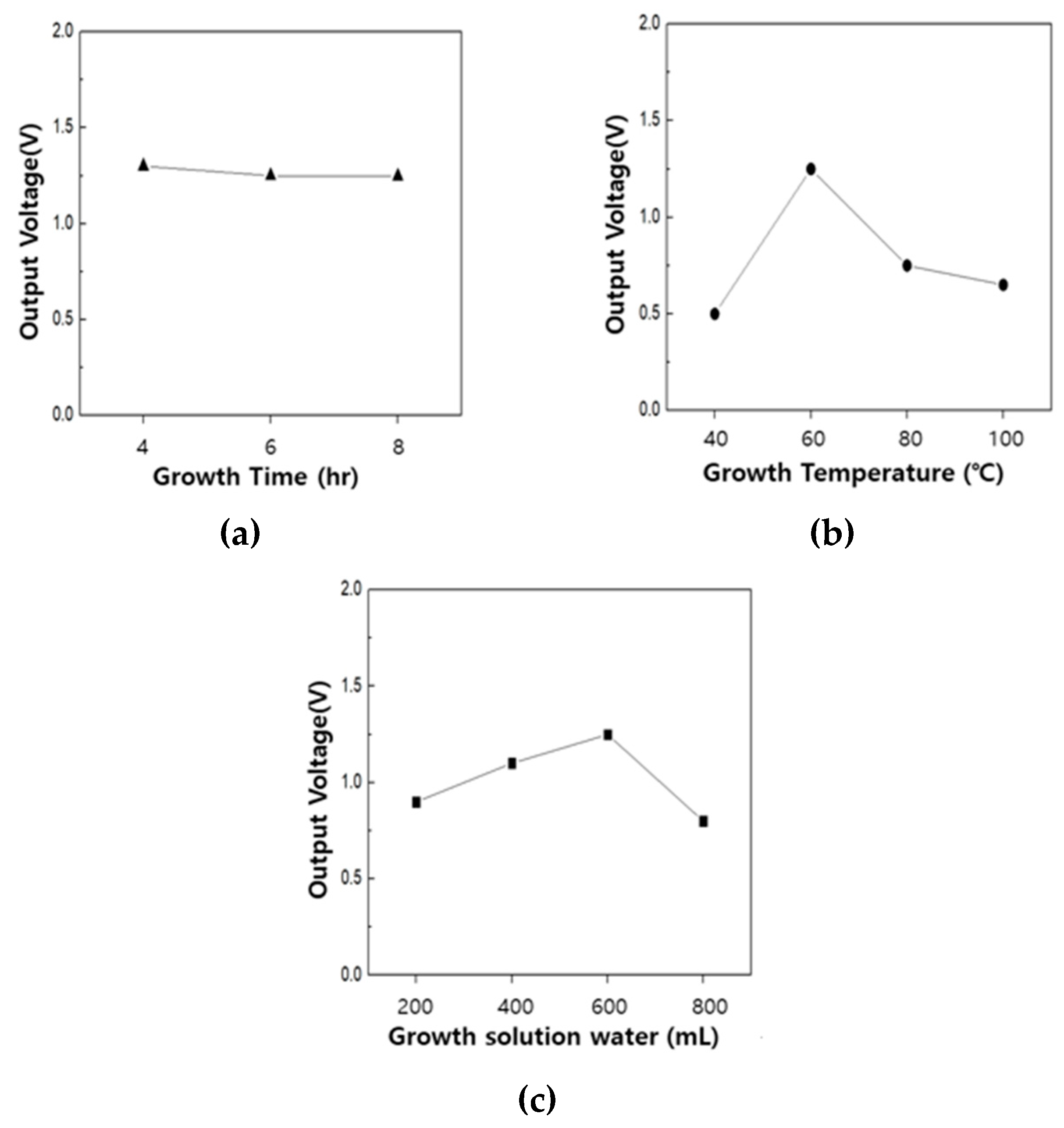
| Sheath component | PVDF (poly(vinylidene fluoride)) |
| Core component | PAR (Polyarylate) |
| Sheath/Core ratio | 1:1 |
| Winding speed | 650 m/min |
| Fiber diameter | 52.9 µm |
| Core component diameter | 36 µm |
| Hexamethylenetetramine (mmol) | Zinc Nitrate Hexahydrate (mmol) | DI Water (mL) | Molarity (M) |
|---|---|---|---|
| 66.7 | 40.0 | 200 | 0.2427 |
| 400 | 0.1214 | ||
| 600 | 0.0809 | ||
| 800 | 0.0607 |
| Temperature (°C) | Time (h) |
|---|---|
| 40 | 6 |
| 60 | 4 |
| 6 | |
| 8 | |
| 80 | 6 |
| 100 | 6 |
| Poling Temperature | Poling Electric Field Intensity (kV/m) | F(β) (%) | Poling Electric Field Intensity (kV/m) | Poling Temperature | F(β) (%) |
|---|---|---|---|---|---|
| 130 °C | 200 | 39.2 | 250 | 110°C | 38 |
| 250 | 38.8 | 120°C | 41.3 | ||
| 300 | 41.3 | 130°C | 42.7 | ||
| - | - | 140°C | 45.1 |
© 2020 by the authors. Licensee MDPI, Basel, Switzerland. This article is an open access article distributed under the terms and conditions of the Creative Commons Attribution (CC BY) license (http://creativecommons.org/licenses/by/4.0/).
Share and Cite
Jeon, M.H.; Lee, Y.R.; Lim, H.S.; Won, J.S.; Lee, S.G. Fabrication of Piezoelectric PVDF/PAR Composites Using a Sheath-Core Fiber Method. Polymers 2020, 12, 2214. https://doi.org/10.3390/polym12102214
Jeon MH, Lee YR, Lim HS, Won JS, Lee SG. Fabrication of Piezoelectric PVDF/PAR Composites Using a Sheath-Core Fiber Method. Polymers. 2020; 12(10):2214. https://doi.org/10.3390/polym12102214
Chicago/Turabian StyleJeon, Min Hong, Yu Rim Lee, Hyeon Soo Lim, Jong Sung Won, and Seung Goo Lee. 2020. "Fabrication of Piezoelectric PVDF/PAR Composites Using a Sheath-Core Fiber Method" Polymers 12, no. 10: 2214. https://doi.org/10.3390/polym12102214





